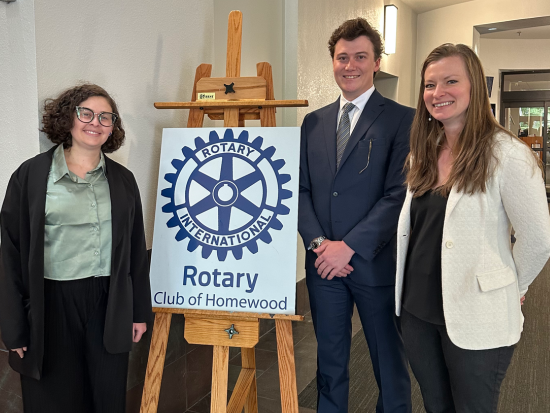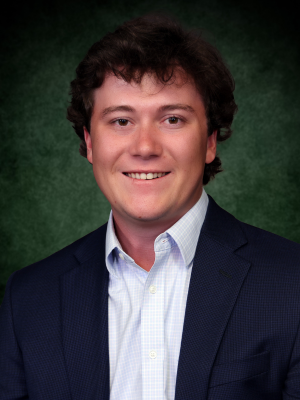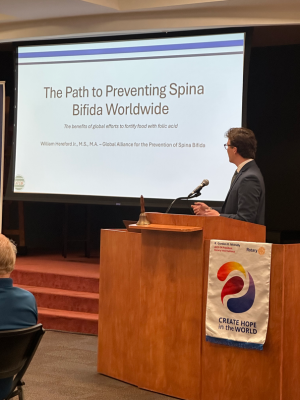 One University of Alabama at Birmingham student is leading grassroots efforts to reduce spina bifida rates across the globe through folic acid fortification. These efforts—which have the potential to transform lives, save millions in healthcare costs and change the future for countless children—have taken William Hereford, MA, MS, from university classrooms to the podiums of local Rotary clubs.
One University of Alabama at Birmingham student is leading grassroots efforts to reduce spina bifida rates across the globe through folic acid fortification. These efforts—which have the potential to transform lives, save millions in healthcare costs and change the future for countless children—have taken William Hereford, MA, MS, from university classrooms to the podiums of local Rotary clubs.
While studying at the University of Alabama, Hereford participated in the Randall Research Scholars Program, where he was first introduced to the Global Alliance for the Prevention of Spina Bifida (GAPSBiF). This worldwide coalition, co-founded by UAB Department of Neurosurgery Division of Pediatric Neurosurgery Professor Jeffrey Blount, M.D., MPH, was formed with the goal of increasing awareness and advocating for the prevention of neural tube defects (NTDs) through large scale folic acid food fortification.
This connection became the catalyst for Hereford's interest in advocating for global folic acid fortification. “I began to better understand the complexities of the care of spina bifida, and, more importantly, that after a child is born with it, it cannot be cured. However, it can be effectively prevented via folic acid fortification, and that was really what caught my eye,” said Hereford.
Spina bifida is a condition that disproportionately affects communities with limited access to folic acid—a vital nutrient for the prevention of NTDs. An estimated 50% to 70% of NTDs are folic acid sensitive, meaning that adequate maternal folic acid intake before and during early pregnancy can have a significant impact in decreasing the occurrence of these defects, including spina bifida. William Hereford, MA, MS
William Hereford, MA, MS
To address this disparity, Hereford began presenting to local Rotary clubs in Birmingham, Alabama, to spread awareness about the preventability of spina bifida and the critical importance of global folic acid fortification. To date, Hereford has presented at both the Rotary Club of Homewood and Rotary Club of Shades Valley. Hereford’s message of global prevention and advocacy was not just well-received—it was eye-opening.
Hereford recalled the moments during his presentations when the audience began to truly understand the gravity of the issue. “When I turned to the fact that this [spina bifida] is something that is easily preventable, both audiences had a very similar—almost audible— reaction. You could hear the ‘aha’ moment within the crowd,” he said.
“Many in the audience were very quick to express their personal experiences with spina bifida, whether it’s their friends and family members, or being healthcare providers themselves,” said Hereford.
The corn masa fortification task force
While Hereford's Rotary Club presentations focused on the broader mission of global folic acid fortification, his involvement with GAPSBiF did not stop there. Recognizing the specific challenges faced by the Hispanic community in the United States, including disproportionate rates of spina bifida, Hereford took on an additional role within GAPSBiF, leading the formation of a corn masa fortification task force.
The FDA mandated folic acid fortification for enriched cereal grains in the late 1990s, but corn masa flour, a staple in the Hispanic diet, was excluded from this mandate, leaving a significant gap in preventive health measures for the Hispanic community.
The lack of mandated fortification has led to devastating consequences for affected families, including a 30% higher rate of divorce and underemployment among parents of children with spina bifida, according to experts in the Department of Neurosurgery.
Hereford’s work with the task force has been instrumental in developing a comprehensive toolkit that consolidates current research, draft legislation and resources for policymakers and other advocates. This toolkit is not just a collection of information; it’s a blueprint for action, designed to empower advocates to push for legislative changes that could save lives.
“We started by drafting legislation that is rooted in the most current research...it really takes a burden off of those that were previously trying to work individually, and allows for consistent strategy and messaging,” noted Hereford.
According to Hereford, interest in the task force has grown among GAPSBiF members, particularly in states with large Hispanic populations, such as Florida. The task force’s multi-pronged approach, which includes both federal and state-level efforts, is making folic acid fortification a political priority, and Hereford’s involvement has been central to this progress.
This effort has resulted in the formation of several state-specific working groups composed of GAPSBiF members nationwide, all aiming to engage with state-level policymakers and introduce legislation in upcoming legislative sessions across multiple states. On a national scale, Hereford is working with Michael Feldman, M.D., a pediatric neurosurgeon at the University of Oklahoma and former pediatric neurosurgery fellow in the UAB Department of Neurosurgery, to establish a federal lobbying coalition. The formation of this coalition would unify the voices of experts and national Hispanic advocacy groups to advance the push for a federal mandate.
The impact of advocacy
Hereford's diverse academic and research background, which includes a master’s degree in biomedical health sciences from UAB, laid a solid foundation for his advocacy involvement. Hereford presenting at a local Rotary club
Hereford presenting at a local Rotary club
Reflecting on his early involvement with research, Hereford shared, “I’ve been involved with several projects that focused on the impact of socioeconomic risk factors on outcomes in a number of neurosurgical conditions, and that’s something that has always captivated my attention.”
For Hereford, the impact of his work goes beyond the immediate goal of reducing spina bifida rates. It has also shaped his career aspirations, reinforcing his desire to pursue a career in medicine. Hereford plans to apply to medical school next year and is currently furthering his education through the UAB Master of Science in Global Health, offered by the Heersink School of Medicine and the School of Public Health.
Hereford emphasized the importance of student involvement in advocacy work. “Health advocacy does not always require formal medical education; it does however require interest and commitment,” he said. “It’s never too late to start. Students interested in healthcare policy advocacy can always start by raising public awareness for an issue. The focus for advocacy shouldn’t be on you or building your resume. Instead, the focus should be on making a difference and addressing a disparity that you’re passionate about.”
“Many times, the drive towards change comes down to awareness, which was the case with the corn masa flour initiative. Even a small group of dedicated people can make a significant impact,” said Hereford.
In Hereford’s opinion, credibility in advocacy often comes not from knowing every detail about a subject, but from conveying passion and projecting confidence. “If you can just convey passion about a topic, that can be enough to grab the attention of the audience,” said Hereford.
His work is a testament to how individuals, even those early in their careers, can drive substantial change in public health.
A call to action
Hereford’s story is far from over. As he continues his advocacy work, he is committed to pushing for the inclusion of corn masa flour in the FDA’s folic acid fortification mandate—a change that could reduce the incidence of spina bifida in the Hispanic community by 30 to 120 cases annually.
Hereford knows that his work is just one part of a larger movement. He believes that public awareness is crucial for addressing spina bifida and folic acid-related issues, and he is dedicated to ensuring that GAPSBiF's message reaches as many people as possible.
As a GAPSBiF member, Hereford is advocating for a future where preventable conditions like spina bifida are a thing of the past.
Hereford's work in the spina bifida community is a powerful example of how anyone, regardless of age or experience, can contribute to making the world a better place. Through his efforts, Hereford is not only addressing a critical public health issue, but also inspiring others to join the fight against preventable conditions and healthcare disparities.